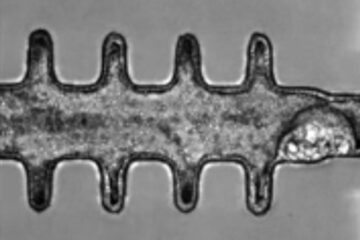New inhibitor has potential as cancer drug

Today a study is being published in the journal Nature Chemical Biology in which Uppsala University researchers show, on the basis of animal models, that an inhibitor for heparanase would be extremely interesting as a drug candidate.
Heparan sulfate is a polysaccharide, that is, a chain of linked sugar units, with sulfate groups in different positions. These chains are found on the surface of practically every cell in the body. The sulfate groups enable binding to a number of proteins, such as inflammation proteins and growth factors. Heparan sulfate can thereby regulate different processes in the body, during embryonic development, for example, but also in various conditions of sickness. The capacity for protein-binding generally increases the more sulfate groups there are on the polysaccharide.
The enzyme heparanase splits heparan sulfate at certain points and converts the long chains into shorter fragments. Research at other laboratories has shown that cancer cells in many cases overproduce heparanase and that the amount of heparanase correlates with the degree of malignancy of the cancer cells and their capacity to metasthesize. The connection is believed to have multiple explanations. Heparanase helps cancer cells make their way through tissue barriers, but it also stimulates the heightened generation of blood vessels that is necessary for tumor growth. The fragments function as carriers of growth factors that can promote tumor growth in many ways.
In the current project the scientists introduced the gene for human heparanase into a mouse, so that the enzyme would be overproduced in several organs. Besides the expected splitting of heparan sulfate, they found that the metabolism of the polysaccharide was stimulated, but that the number of sulfate groups increased at the same time.
The ‘high-sulfated’ fragments released by the enzyme evince dramatically increased binding to certain growth factors of potential importance to tumor growth. When they examined heparan sulfate from authentic cancer cells instead, or from cancer tissue that had overproduced heparanase, it was found that here too there was an increase in the number of sulfate groups compared with heparan sulfate from corresponding normal cells/tissues. The findings indicate that producing an inhibitor for heparanase is an urgent step in discovering new drugs for cancer.
Media Contact
All latest news from the category: Life Sciences and Chemistry
Articles and reports from the Life Sciences and chemistry area deal with applied and basic research into modern biology, chemistry and human medicine.
Valuable information can be found on a range of life sciences fields including bacteriology, biochemistry, bionics, bioinformatics, biophysics, biotechnology, genetics, geobotany, human biology, marine biology, microbiology, molecular biology, cellular biology, zoology, bioinorganic chemistry, microchemistry and environmental chemistry.
Newest articles

Solving the riddle of the sphingolipids in coronary artery disease
Weill Cornell Medicine investigators have uncovered a way to unleash in blood vessels the protective effects of a type of fat-related molecule known as a sphingolipid, suggesting a promising new…

Rocks with the oldest evidence yet of Earth’s magnetic field
The 3.7 billion-year-old rocks may extend the magnetic field’s age by 200 million years. Geologists at MIT and Oxford University have uncovered ancient rocks in Greenland that bear the oldest…

Mini-colons revolutionize colorectal cancer research
As our battle against cancer rages on, the quest for more sophisticated and realistic models to study tumor development has never been more critical. Until now, research has relied on…





















